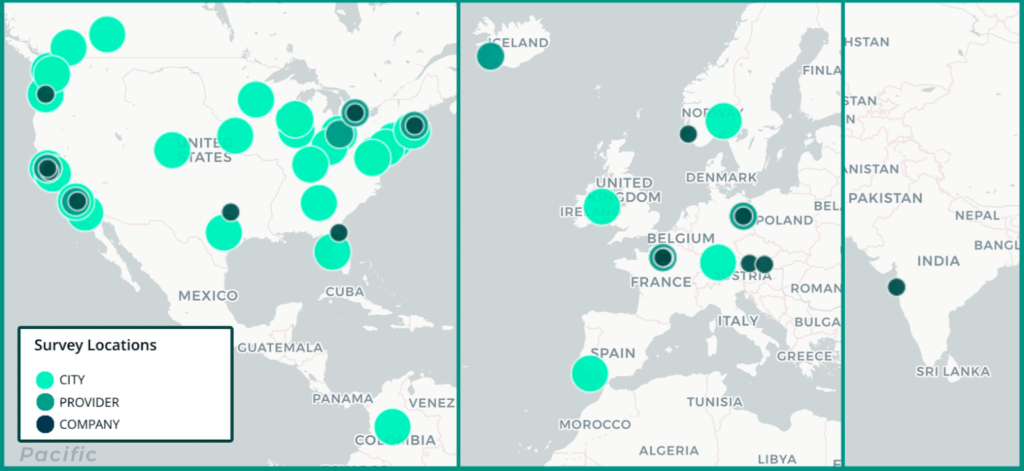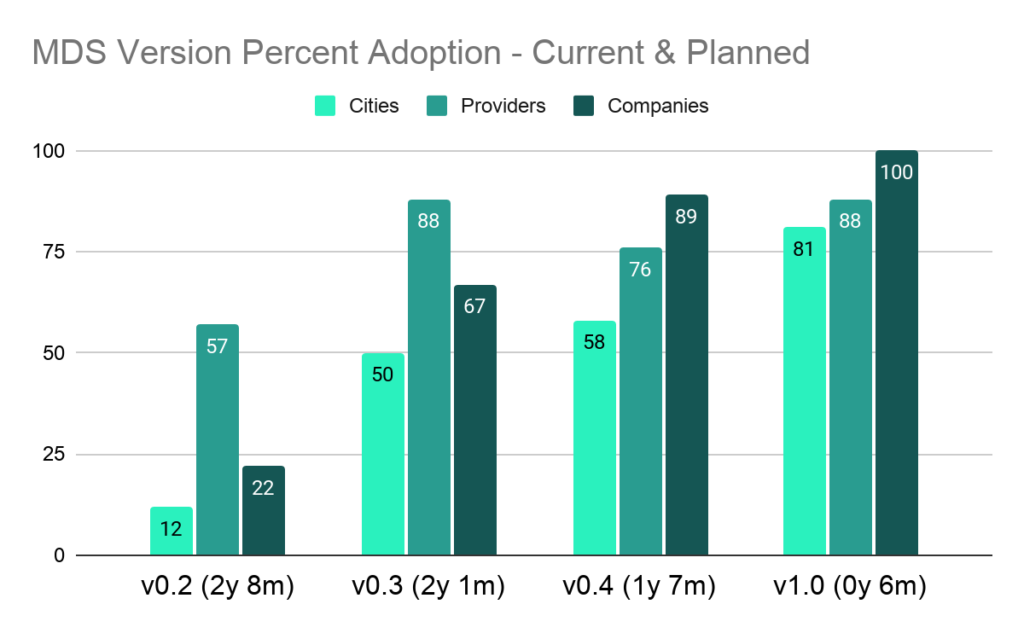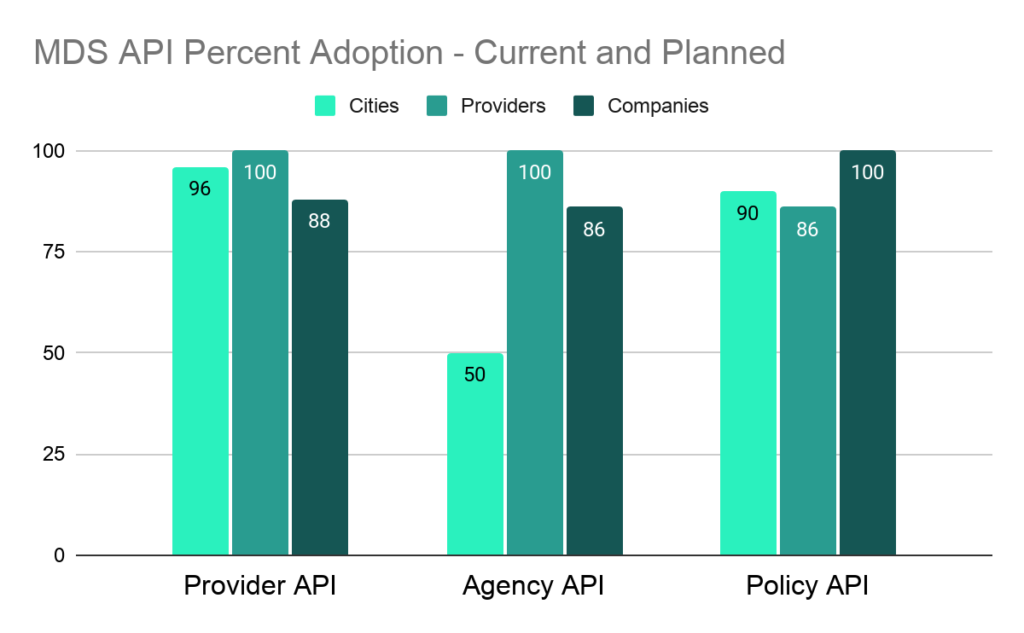Last month, the Open Mobility Foundation launched a survey for MDS users as part of an ongoing effort to learn more about the use of the Mobility Data Specification (MDS) across the world. The goal of this survey was to help prioritize the development of features, allocate resources, and better understand how we can support adoption of new versions. In addition to insights about the use of different versions, APIs, and beta features, we also learned more about the cities and companies using MDS, some of which might be a surprise.
Before we dig into the findings, it’s important to note the survey’s respondents. We reached out to cities and companies based in Europe, Australia, North and South America, and other locations to encourage participation in this effort. More than 75 individuals from 60 unique organizations responded – including cities (city governments, agencies, or MPOs), providers (mobility service providers, or operators), and companies (third party software companies). Despite the fact that MDS is being used in more than 115 cities around the world, the responses are mostly from cities in North America and western Europe. And, less than half of providers known to be using MDS responded. We continue to work toward getting more comprehensive feedback from the wide range of MDS users across the globe.

Map of the 60 locations of city, company, and provider respondents to the State of MDS Survey. Note some overlapping organizations may not be visible.
MDS for All
One of the common myths when working with city governments is that MDS – or, digital tools more generally – are made for use in larger cities. The reality is that cities of all sizes are using MDS. According to survey results, approximately ⅔ of cities using MDS are less than one million in population size. This aligns with how MDS was designed – to be a flexible toolkit that cities can implement in whole or in parts to meet their varying use cases.
Updates Across the Ecosystem
Since MDS was created, there have been 11 releases (5 of them major), or versions. As an open source project, the OMF makes recommendations about which versions of MDS to use, but doesn’t require cities or companies using MDS to report what version they’re on or if they’re using MDS at all. Through the survey, we discovered that upgrades are on the horizon across the ecosystem. The shift to align use around recommended versions will benefit cities and companies alike.
Digging into the specifics, version use and future plans vary slightly by the type of organization using MDS. When it comes to public agencies and software companies, version 0.4 is the most popular, with 58% of agencies and 78% of software companies using it. Currently version 0.3 is the most popular with mobility service providers, with 88% using it. However, upgrades are widely planned: of the 58% of agencies planning to upgrade in the next year, 100% of them are planning to upgrade to version 1.0. Of the software companies planning to upgrade in the next year, 83% of them are planning to upgrade to version 1.0. The latest major version – 1.0 – is supported or planned to be supported by 88% of mobility service providers and 100% of software companies as well.

Percent of organizations currently supporting or planning to support within a year, for each MDS release. Parentheses indicate the years and months since the release was published.
While many are planning to move forward with new versions, there are a variety of factors holding both cities and companies back from using updated versions, chief amongst them being lack of staff resources. In the wake of the pandemic’s far-reaching impact on mobility, it’s important to remember that organizations across the space are adjusting to changes in staffing and budgeting that impact the adoption of and ability to support a wide range of versions. Additionally, many providers and companies are tasked with supporting a wide range of versions, which can add to the challenge of upgrading.
When asked what the OMF could do to support the adoption of new versions, the top three responses from a variety of options provided were:
- Documentation explaining version differences and upgrade benefits
- Sample language to communicate version requirements to providers
- Referenceable upgrade schedule recommended by the OMF
The OMF looks forward to improving and sharing these resources more effectively as a result of this survey.
Pace of Change
These days, the OMF releases a new version of MDS roughly every six months, with about one major release annually. As a big tent organization, there is a healthy push-and-pull between making improvements to existing elements while also moving forward in new directions to accommodate emerging modes or other advancements. The good news is that the OMF represents a dynamic community of collaborators, and no MDS user surveyed firmly believes the pace of change is not fast enough.

What each organization type thinks about the pace of MDS releases.
The majority of respondents think the pace of development is just right, while some hold the point of view that the pace is too rapid. The sentiment that development is too rapid skews toward the private sector, and therefore may be related to common industry pain points. For example, the need to support multiple versions of MDS simultaneously, or to adhere to permit requirements which don’t provide adequate time to make updates – all of which are important considerations in the pace of change.
Popular APIs and Features
MDS is made up of the three primary APIs – Provider, Policy, and Agency – which allow cities and providers to communicate in different ways. The use of these APIs and features (or endpoints) within them vary, giving cities and providers a choice with which they want to implement and support.
While it shouldn’t surprise those familiar with MDS that the most popular API is Provider, there is also very high planned usage of Agency (50-100%), and by far most providers already support it (86%). In fact, there are examples of both cities and companies only supporting Agency (and not Provider at all). Additionally, there is very high planned usage of Policy (86-100%) across the board within the next year, and 15-38% of all respondents are already using/supporting it.

Percent of organizations currently supporting or planning to support within a year each MDS API.
Beta Feature Adoption
Some new features in MDS are marked as beta features, to allow the community a chance to put them into practice, provide feedback, and adjust them as needed. The Vehicles and Stops endpoints are beta features that launched with release of versions 0.4.1 and 1.0.0 respectively. Understanding how widely these features are being implemented, and gathering any learnings about their use, will help inform the process of moving them out of beta.
Survey results show that adoption is higher than is often speculated, with about half of agencies using Vehicles, most providers, and almost all companies supporting it. About a third of agencies are using Stops, almost no providers are, and most companies are. We are gathering feedback on these features to see how they are being used by the community.
What’s Next
The OMF is looking forward to developing tools to assist with version transition, including more robust documentation explaining version differences and upgrade benefits, updated sample language to communicate version requirements to mobility service providers, and a recommended upgrade schedule. We’re also thrilled to bring these learnings – and more – back to our members for use in future MDS development cycles, while we work to improve not only the specification, but also the collaborative process of creating it.




